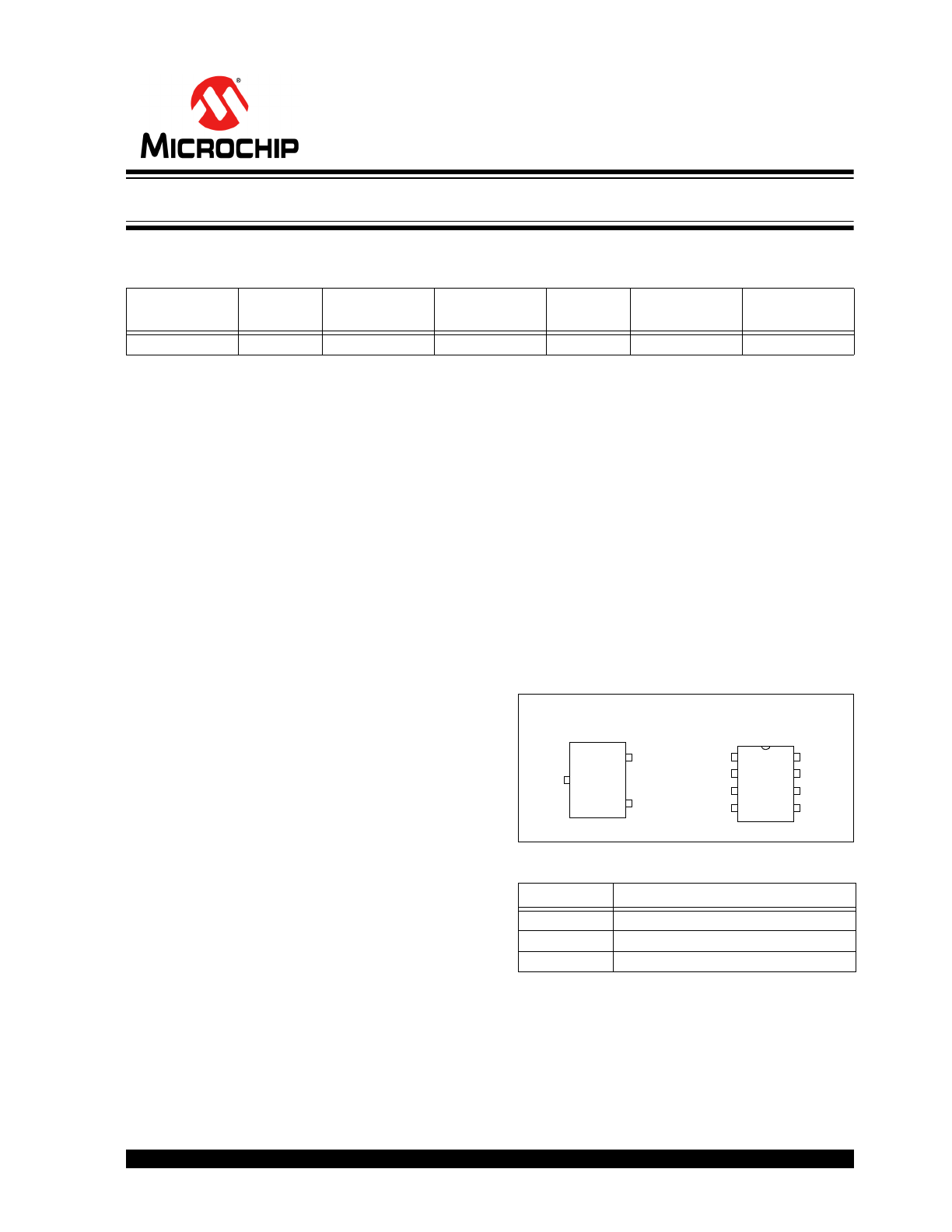
2013 Microchip Technology Inc.
DS20005206A-page 1
11AA02UID
DEVICE SELECTION TABLE
Features:
• Preprogrammed 32-Bit Serial Number:
- Unique across all UID-family EEPROMs
- Scalable to 48-bit, 64-bit, 128-bit, 256-bit,
and other lengths
• Single I/O, UNI/O
®
Serial Interface Bus
• Low-Power CMOS Technology:
- 1 mA active current, typical
- 1 µA standby current (max.)
• 256 x 8 Bit Organization
• Schmitt Trigger Inputs for Noise Suppression
• Output Slope Control to Eliminate Ground Bounce
• 100 kbps Max. Bit Rate – Equivalent to 100 kHz
Clock Frequency
• Self-Timed Write Cycle (including Auto-Erase)
• Page-Write Buffer for up to 16 Bytes
• STATUS Register for Added Control:
- Write enable latch bit
- Write-In-Progress bit
• Block Write Protection:
- Protect none, 1/4, 1/2 or all of array
• Built-in Write Protection:
- Power-on/off data protection circuitry
- Write enable latch
• High Reliability:
- Endurance: 1,000,000 erase/write cycles
- Data retention: > 200 years
- ESD protection: > 4,000V
• 3-Lead SOT-23 and 8-Lead SOIC Packages
• RoHS Compliant
• Available Temperature Ranges:
Description:
The Microchip Technology Inc. 11AA02UID device is a
2 Kbit Serial Electrically Erasable PROM with a
preprogrammed, 32-bit unique ID. The device is
organized in blocks of x8-bit memory and support the
patented* single I/O UNI/O
®
serial bus. By using
Manchester encoding techniques, the clock and data
are combined into a single, serial bit stream (SCIO),
where the clock signal is extracted by the receiver to
correctly decode the timing and value of each bit.
Low-voltage design permits operation down to 1.8V,
with standby and active currents of only 1 uA and 1 mA,
respectively.
The 11AA02UID is available in standard 8-lead SOIC
and 3-lead SOT-23 packages.
Package Types (not to scale)
Pin Function Table
Part Number
Density
(bits)
V
CC
Range
Page Size
(Bytes)
Temp.
Ranges
Packages
Unique ID
Length
11AA02UID
2K
1.8-5.5V
16
I
SN, TT
32-Bit
- Industrial (I):
-40°C to
+85°C
Name
Function
SCIO
Serial Clock, Data Input/Output
V
SS
Ground
V
CC
Supply Voltage
NC
NC
NC
V
SS
1
2
3
4
8
7
6
5
V
CC
NC
NC
SCIO
SOIC
(SN)
SOT23
2
3
1 SCIO
V
CC
V
SS
(TT)
2K UNI/O
®
Serial EEPROM with Unique 32-Bit Serial Number
* Microchip’s UNI/O
®
Bus products are covered by the following patents issued in the U.S.A.: 7,376,020 and 7,788,430.

11AA02UID
DS20005206A-page 2
2013 Microchip Technology Inc.
1.0
ELECTRICAL CHARACTERISTICS
Absolute Maximum Ratings
(†)
V
CC
.............................................................................................................................................................................6.5V
SCIO w.r.t. V
SS
.................................................................................................................................... -0.6V to V
CC
+1.0V
Storage temperature .................................................................................................................................-65°C to 150°C
Ambient temperature under bias .................................................................................................................-40°C to 85°C
ESD protection on all pins ..........................................................................................................................................4 kV
TABLE 1-1:
DC CHARACTERISTICS
† NOTICE: Stresses above those listed under ‘Absolute Maximum Ratings’ may cause permanent damage to the
device. This is a stress rating only and functional operation of the device at those or any other conditions above those
indicated in the operational listings of this specification is not implied. Exposure to maximum rating conditions for an
extended period of time may affect device reliability.
DC CHARACTERISTICS
Electrical Characteristics:
Industrial (I):
V
CC
= 2.5V to 5.5V
T
A
= -40°C to +85°C
V
CC
= 1.8V to 2.5V
T
A
= -20°C to +85°C
Param.
No.
Sym.
Characteristic
Min.
Max.
Units
Test Conditions
D1
V
IH
High-level Input
Voltage
0.7*V
CC
V
CC
+1
V
D2
V
IL
Low-level Input
Voltage
-0.3
-0.3
0.3*V
CC
0.2*V
CC
V
V
V
CC
2.5V
V
CC
< 2.5V
D3
V
HYS
Hysteresis of Schmitt
Trigger inputs (SCIO)
0.05*Vcc
—
V
V
CC
2.5V (
Note 1
)
D4
V
OH
High-level Output
Voltage
V
CC
-0.5
V
CC
-0.5
—
—
V
V
I
OH
= -300
A, V
CC
= 5.5V
I
OH
= -200
A, Vcc = 2.5V
D5
V
OL
Low-level Output
Voltage
—
—
0.4
0.4
V
V
I
O
I = 300
A, V
CC
= 5.5V
I
O
I = 200
A, Vcc = 2.5V
D6
I
O
Output Current Limit
(
Note 2
)
—
—
±4
±3
mA
mA
V
CC
= 5.5V (
Note 1
)
Vcc = 2.5V (
Note 1
)
D7
I
LI
Input Leakage
Current (SCIO)
—
±1
A
V
IN
= V
SS
or V
CC
D8
C
INT
Internal Capacitance
(all inputs and
outputs)
—
7
pF
T
A
= 25°C, F
CLK
= 1 MHz,
V
CC
= 5.0V (
Note 1
)
D9
I
CC
Read Read Operating
Current
—
—
3
1
mA
mA
V
CC
=5.5V, F
BUS
=100 kHz, C
B
=100 pF
V
CC
=2.5V, F
BUS
=100 kHz, C
B
=100 pF
D10
I
CC
Write Write Operating
Current
—
—
5
3
mA
mA
V
CC
= 5.5V
V
CC
= 2.5V
D11
Iccs
Standby Current
—
1
A
V
CC
= 5.5V, T
A
= 85°C
D12
I
CCI
Idle Mode Current
—
50
A
V
CC
= 5.5V
Note 1:
This parameter is periodically sampled and not 100% tested.
2:
The SCIO output driver impedance will vary to ensure I
O
is not exceeded.

2013 Microchip Technology Inc.
DS20005206A-page 3
11AA02UID
TABLE 1-3:
AC TEST CONDITIONS
TABLE 1-2:
AC CHARACTERISTICS
AC CHARACTERISTICS
Electrical Characteristics:
Industrial (I):
V
CC
= 2.5V to 5.5V
T
A
= -40°C to +85°C
V
CC
= 1.8V to 2.5V
T
A
= -20°C to +85°C
Param.
No.
Sym.
Characteristic
Min.
Max.
Units
Test Conditions
1
F
BUS
Serial Bus Frequency
10
100
kHz
—
2
T
E
Bit Period
10
100
µs
—
3
T
IJIT
Input Edge Jitter
Tolerance
—
±0.06
UI
(
Note 3
)
4
F
DRIFT
Serial Bus Frequency
Drift Rate Tolerance
—
±0.50
% per byte —
5
F
DEV
Serial Bus Frequency
Drift Limit
—
±5
% per
command
—
6
T
OJIT
Output Edge Jitter
—
±0.25
UI
(
Note 3
)
7
T
R
SCIO Input Rise Time
(
Note 1
)
—
100
ns
—
8
T
F
SCIO Input Fall Time
(
Note 1
)
—
100
ns
—
9
T
STBY
Standby Pulse Time
600
—
µs
—
10
T
SS
Start Header Setup Time
10
—
µs
—
11
T
HDR
Start Header Low Pulse
Time
5
—
µs
—
12
T
SP
Input Filter Spike
Suppression (SCIO)
—
50
ns
(
Note 1
)
13
T
WC
Write Cycle Time
(byte or page)
—
—
5
10
ms
ms
Write, WRSR commands
ERAL, SETAL commands
14
—
Endurance (per page)
1M
—
cycles
25°C, V
CC
= 5.5V (
Note 2
)
Note 1: This parameter is periodically sampled and not 100% tested.
2: This parameter is not tested but ensured by characterization. For endurance estimates in a specific
application, please consult the Total Endurance
™
Model which can be obtained on Microchip’s web site at
www.microchip.com.
3:
A Unit Interval (UI) is equal to 1-bit period (T
E
) at the current bus frequency.
AC Waveform:
V
LO
= 0.2V
V
HI
= V
CC
- 0.2V
C
L
= 100 pF
Timing Measurement Reference Level
Input
0.5 V
CC
Output
0.5 V
CC
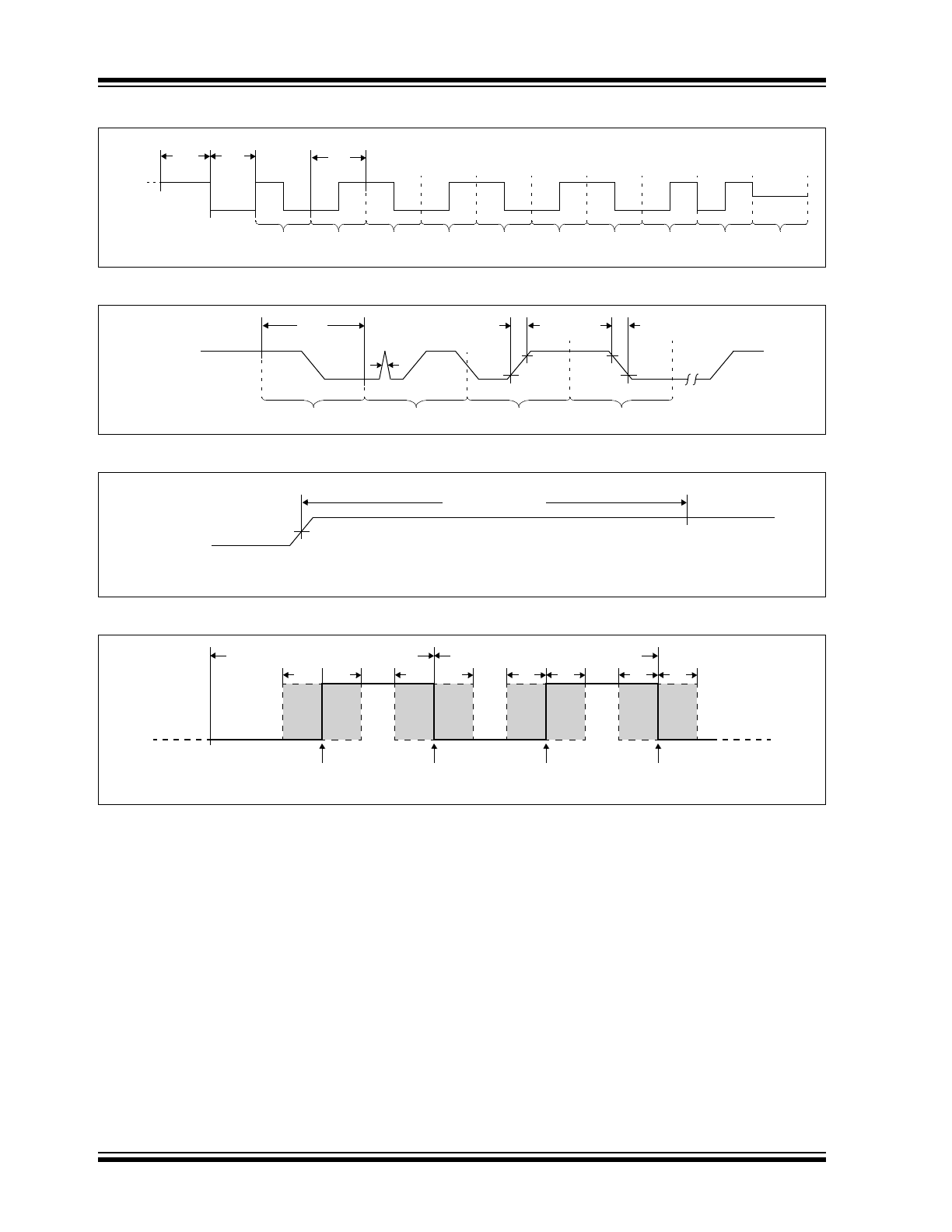
11AA02UID
DS20005206A-page 4
2013 Microchip Technology Inc.
FIGURE 1-1:
BUS TIMING – START HEADER
FIGURE 1-2:
BUS TIMING – DATA
FIGURE 1-3:
BUS TIMING – STANDBY PULSE
FIGURE 1-4:
BUS TIMING – JITTER
SCIO
2
Data ‘0’ Data ‘1’ Data ‘0’ Data ‘1’ Data ‘0’ Data ‘1’ Data ‘0’ Data ‘1’ MAK bit NoSAK bit
11
10
2
SCIO
7
8
Data ‘0’
Data ‘1’
Data ‘1’
Data ‘0’
12
SCIO
9
Standby
Mode
Ideal Edge
3
2
3
6
6
2
6
6
Ideal Edge
Ideal Edge
Ideal Edge
from Master
from Master
from Slave
from Slave
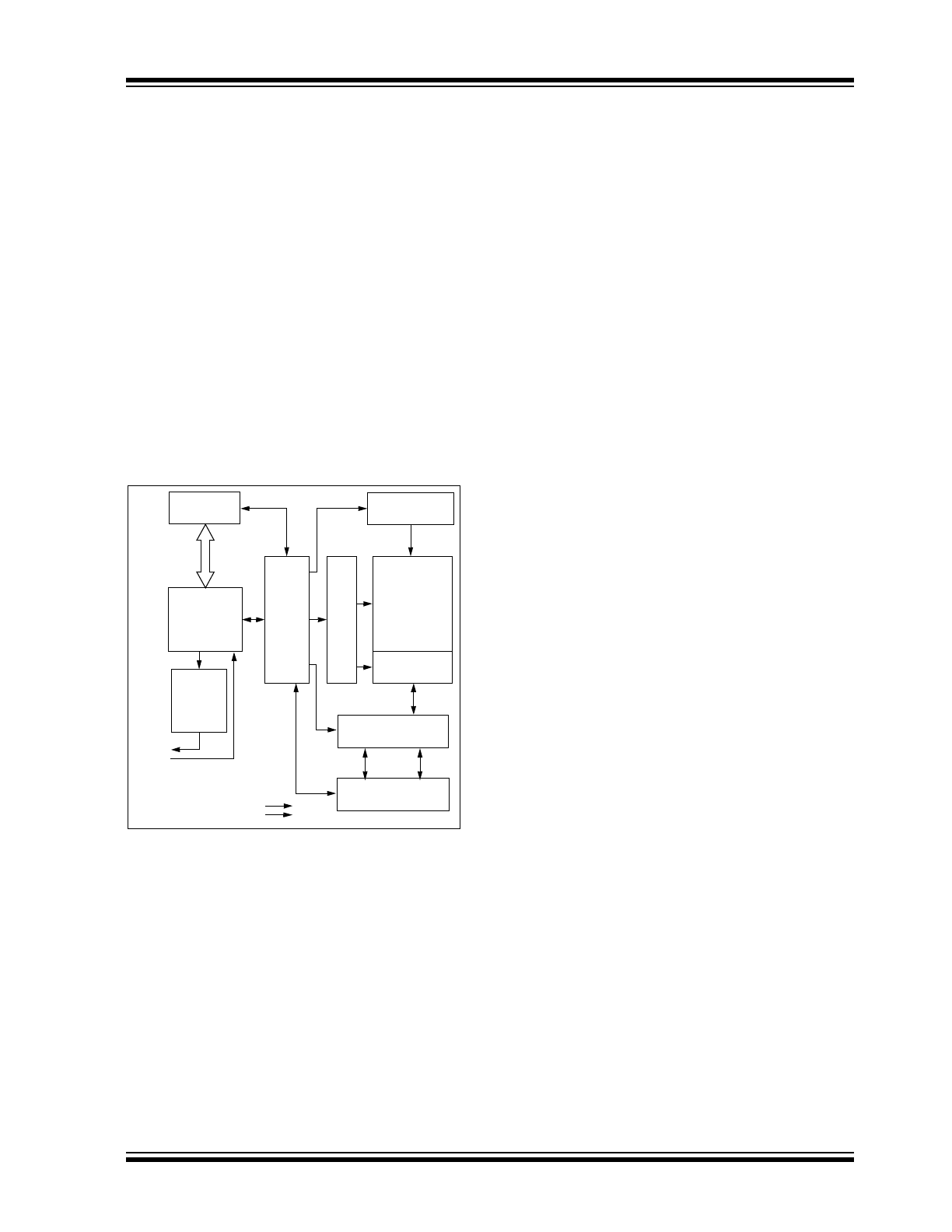
2013 Microchip Technology Inc.
DS20005206A-page 5
11AA02UID
2.0
FUNCTIONAL DESCRIPTION
2.1
Principles of Operation
The 11AA02UID family of serial EEPROMs support
the UNI/O
®
protocol. They can be interfaced with
microcontrollers, including Microchip’s PIC
®
microcon-
trollers, ASICs, or any other device with an available
discrete I/O line that can be configured properly to
match the UNI/O protocol.
The 11AA02UID devices contain an 8-bit instruction
register. The devices are accessed via the SCIO pin.
Data is embedded into the I/O stream through
Manchester encoding. The bus is controlled by a
master device which determines the clock period, con-
trols the bus access and initiates all operations, while
the 11AA02UID works as slave. Both master and slave
can operate as transmitter or receiver, but the master
device determines which mode is active.
FIGURE 2-1:
BLOCK DIAGRAM
SCIO
STATUS
Register
I/O Control
Memory
Control
Logic
X
Dec
HV Generator
EEPROM
Array
Page Latches
Y Decoder
Sense Amp.
R/W Control
Logic
V
CC
V
SS
Current-
Limited
Slope
Control
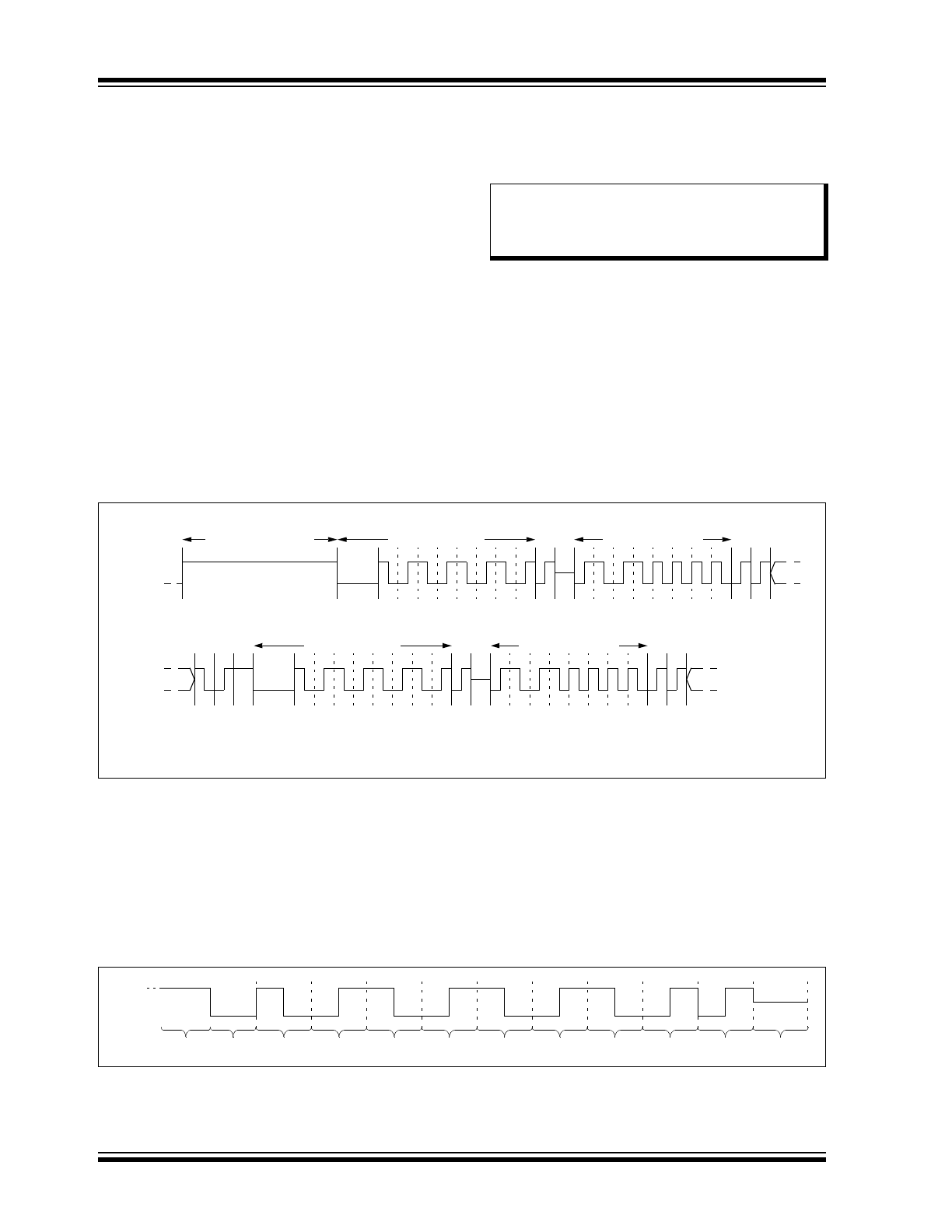
11AA02UID
DS20005206A-page 6
2013 Microchip Technology Inc.
3.0
BUS CHARACTERISTICS
3.1
Standby Pulse
When the master has control of SCIO, a standby pulse
can be generated by holding SCIO high for T
STBY
. At
this time, the 11AA02UID will reset and return to
Standby mode. Subsequently, a high-to-low transition
on SCIO (the first low pulse of the header) will return
the device to the active state.
Once a command is terminated satisfactorily (i.e., via
a NoMAK/SAK combination during the Acknowledge
sequence), performing a standby pulse is not required
to begin a new command as long as the device to be
selected is the same device selected during the previ-
ous command. However, a period of T
SS
must be
observed after the end of the command and before the
beginning of the start header. After T
SS
, the start
header (including T
HDR
low pulse) can be transmitted
in order to begin the new command.
If a command is terminated in any manner other than a
NoMAK/SAK combination, then the master must
perform a standby pulse before beginning a new
command, regardless of which device is to be selected.
An example of two consecutive commands is shown in
Figure 3-1
. Note that the device address is the same
for both commands, indicating that the same device is
being selected both times.
A standby pulse cannot be generated while the slave
has control of SCIO. In this situation, the master must
wait for the slave to finish transmitting and to release
SCIO before the pulse can be generated.
If, at any point during a command an error is detected
by the master, a standby pulse should be generated
and the command should be performed again.
FIGURE 3-1:
CONSECUTIVE COMMANDS EXAMPLE
3.2
Start Data Transfer
All operations must be preceded by a start header. The
start header consists of holding SCIO low for a period
of T
HDR
, followed by transmitting an 8-bit ‘
01010101
’
code. This code is used to synchronize the slave’s
internal clock period with the master’s clock period, so
accurate timing is very important.
When a standby pulse is not required (i.e., between
successive commands to the same device), a period of
T
SS
must be observed after the end of the command
and before the beginning of the start header.
Figure 3-2
shows the waveform for the start header,
including the required Acknowledge sequence at the
end of the byte.
FIGURE 3-2:
START HEADER
Note:
After a POR/BOR event occurs, a low-to-
high transition on SCIO must be gener-
ated before proceeding with communica-
tion, including a standby pulse.
1
1
0
1
0
1
0
0
Start Header
SCIO
Device Address
MA
K
0
0
0
0
1
0
1
0
MA
K
NoSAK
SAK
Standby Pulse
(1)
1
1
0
1
0
1
0
0
Start Header
SCIO
Device Address
MA
K
0
0
0
0
1
0
1
0
MA
K
NoSAK
SA
K
No
M
A
K
SA
K
T
SS
Note 1: After a POR/BOR event, a low-to-high transition on SCIO is required to occur before the first
standby pulse.
SCIO
Data ‘0’ Data ‘1’ Data ‘0’ Data ‘1’ Data ‘0’ Data ‘1’ Data ‘0’ Data ‘1’
MAK
NoSAK
T
SS
T
HDR
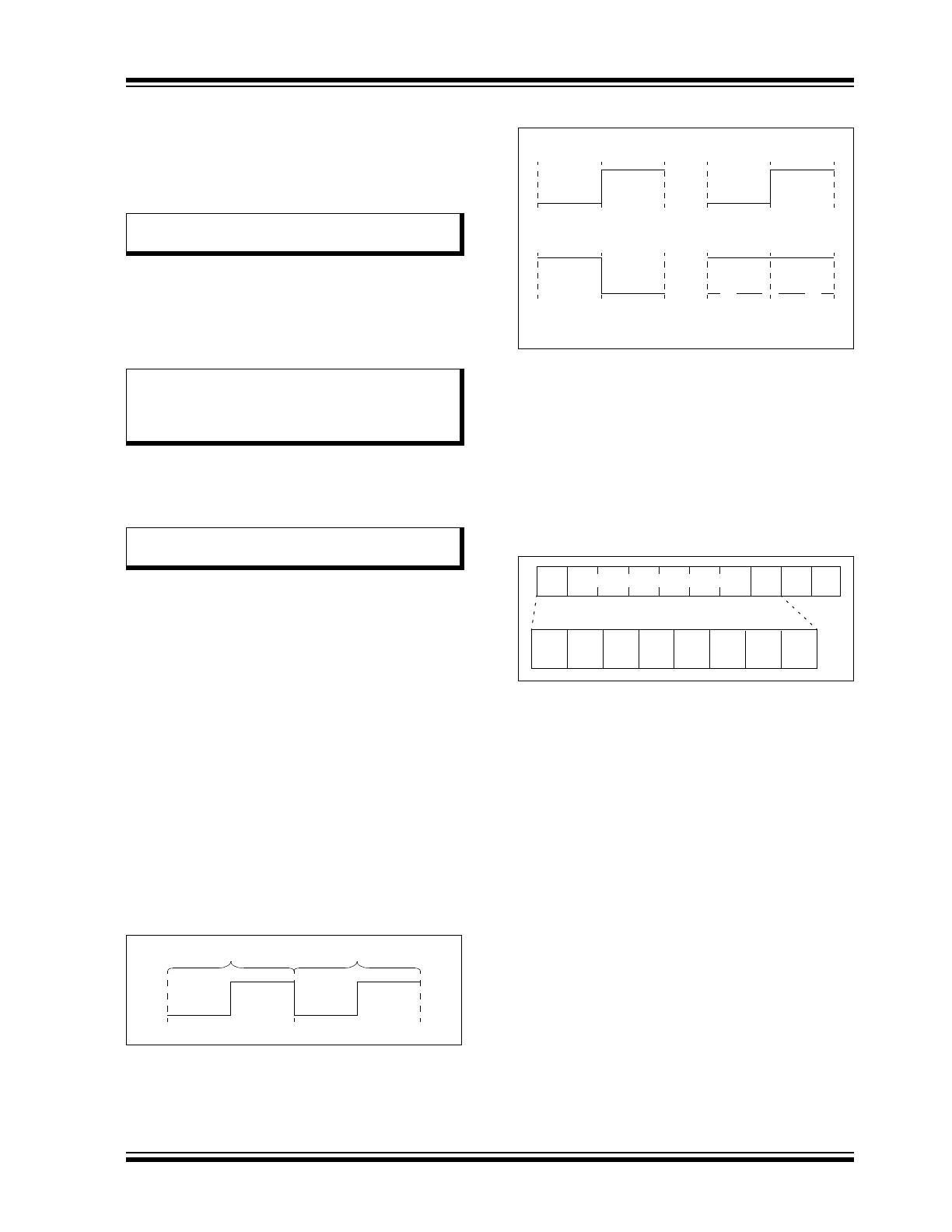
2013 Microchip Technology Inc.
DS20005206A-page 7
11AA02UID
3.3
Acknowledge
An Acknowledge routine occurs after each byte is
transmitted, including the start header. This routine
consists of two bits. The first bit is transmitted by the
master, and the second bit is transmitted by the slave.
The Master Acknowledge, or MAK, is signified by trans-
mitting a ‘
1
’, and informs the slave that the current
operation is to be continued. Conversely, a Not
Acknowledge, or NoMAK, is signified by transmitting a
‘0’, and is used to end the current operation (and initiate
the write cycle for write operations).
The slave Acknowledge, or SAK, is also signified by
transmitting a ‘
1
’, and confirms proper communication.
However, unlike the NoMAK, the NoSAK is signified by
the lack of a middle edge during the bit period.
A NoSAK will occur for the following events:
• Following the start header
• Following the device address, if no slave on the
bus matches the transmitted address
• Following the command byte, if the command is
invalid, including Read, CRRD, Write, WRSR,
SETAL, and ERAL during a write cycle.
• If the slave becomes out of sync with the master
• If a command is terminated prematurely by using
a NoMAK, with the exception of immediately after
the device address.
See
Figure 3.3
and
Figure 3-4
for details.
If a NoSAK is received from the slave after any byte
(except the start header), an error has occurred. The
master should then perform a standby pulse and begin
the desired command again.
FIGURE 3-3:
ACKNOWLEDGE
ROUTINE
FIGURE 3-4:
ACKNOWLEDGE BITS
3.4
Device Addressing
A device address byte is the first byte received from the
master device following the start header. The device
address byte consists of a 4-bit family code, for the
11AA02UID this is set as ‘
1010
’. The last four bits of
the device address byte are the device code, which is
hardwired to ‘
0000
’.
FIGURE 3-5:
DEVICE ADDRESS BYTE
ALLOCATION
3.5
Bus Conflict Protection
To help guard against high current conditions arising
from bus conflicts, the 11AA02UID features a current-
limited output driver. The I
OL
and I
OH
specifications
describe the maximum current that can be sunk or
sourced, respectively, by the SCIO pin. The
11AA02UID will vary the output driver impedance to
ensure that the maximum current level is not exceeded.
Note:
A MAK must always be transmitted
following the start header.
Note:
When a NoMAK is used to end a
WRITE
or
WRSR
instruction, the write cycle is not
initiated if no bytes of data have been
received.
Note:
In order to guard against bus contention, a
NoSAK will occur after the start header.
Master
Slave
MAK
SAK
MAK (‘1’)
NoMAK (‘0’)
SAK (‘1’)
NoSAK
(1)
Note 1:
valid SAK.
A NoSAK is defined as any sequence that is not a
1
0
1
0
0
0
0
MAK
SLAVE ADDRESS
0
SAK

11AA02UID
DS20005206A-page 8
2013 Microchip Technology Inc.
3.6
Device Standby
The 11AA02UID features a low-power Standby mode
during which the device is waiting to begin a new
command. A high-to-low transition on SCIO will exit
Low-Power mode and prepare the device for receiving
the start header.
Standby mode will be entered upon the following
conditions:
• A NoMAK followed by a SAK (i.e., valid termina-
tion of a command)
• Reception of a standby pulse
3.7
Device Idle
The 11AA02UID features an Idle mode during which
all serial data is ignored until a standby pulse occurs.
Idle mode will be entered upon the following condi-
tions:
• Invalid device address
• Invalid command byte, including Read, CRRD,
Write, WRSR, SETAL and ERAL during a write
cycle.
• Missed edge transition
• Reception of a MAK following a WREN, WRDI,
SETAL, or ERAL command byte
• Reception of a MAK following the data byte of a
WRSR command
An invalid start header will indirectly cause the device
to enter Idle mode. Whether or not the start header is
invalid cannot be detected by the slave, but will
prevent the slave from synchronizing properly with the
master. If the slave is not synchronized with the
master, an edge transition will be missed, thus causing
the device to enter Idle mode.
3.8
Synchronization
At the beginning of every command, the 11AA02UID
utilizes the start header to determine the master’s bus
clock period. This period is then used as a reference for
all subsequent communication within that command.
The 11AA02UID features re-synchronization circuitry
which will monitor the position of the middle data edge
during each MAK bit and subsequently adjust the inter-
nal time reference in order to remain synchronized with
the master.
There are two variables which can cause the
11AA02UID to lose synchronization. The first is
frequency drift, defined as a change in the bit period,
T
E
. The second is edge jitter, which is a single occur-
rence change in the position of an edge within a bit
period, while the bit period itself remains constant.
3.8.1
FREQUENCY DRIFT
Within a system, there is a possibility that frequencies
can drift due to changes in voltage, temperature, etc.
The re-synchronization circuitry provides some toler-
ance for such frequency drift. The tolerance range is
specified by two parameters, F
DRIFT
and F
DEV
. F
DRIFT
specifies the maximum tolerable change in bus fre-
quency per byte. F
DEV
specifies the overall limit in fre-
quency deviation within an operation (i.e., from the end
of the start header until communication is terminated
for that operation). The start header at the beginning of
the next operation will reset the re-synchronization
circuitry and allow for another F
DEV
amount of
frequency drift.
3.8.2
EDGE JITTER
Ensuring that edge transitions from the master always
occur exactly in the middle or end of the bit period is not
always possible. Therefore, the re-synchronization
circuitry is designed to provide some tolerance for edge
jitter.
The 11AA02UID adjusts its phase every MAK bit, so
T
IJIT
specifies the maximum allowable peak-to-peak
jitter relative to the previous MAK bit. Since the position
of the previous MAK bit would be difficult to measure by
the master, the minimum and maximum jitter values for
a system should be considered the worst-case. These
values will be based on the execution time for different
branch paths in software, jitter due to thermal noise,
etc.
The difference between the minimum and maximum
values, as a percentage of the bit period, should be cal-
culated and then compared against T
IJIT
to determine
jitter compliance.
Note:
In the case of the WRITE, WRSR, SETAL,
or ERAL commands, the write cycle is
initiated upon receipt of the NoMAK,
assuming all other write requirements
have been met.
Note:
Because the 11AA02UID only re-synchro-
nizes during the MAK bit, the overall ability
to remain synchronized depends on a
combination of frequency drift and edge
jitter (i.e., if the MAK bit edge is experienc-
ing the maximum allowable edge jitter,
then there is no room for frequency drift).
Conversely, if the frequency has drifted to
the maximum amount tolerable within a
byte, then no edge jitter can be present.
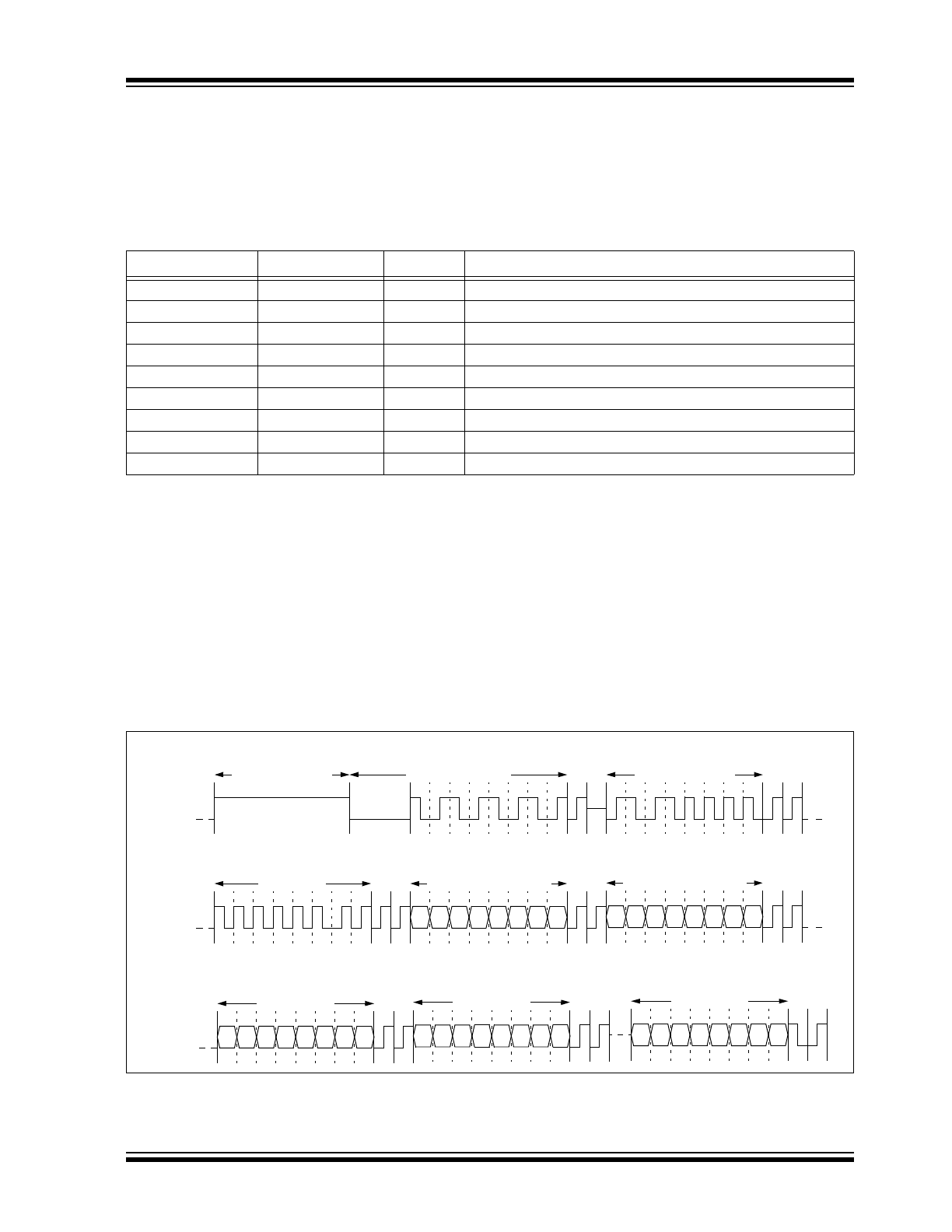
2013 Microchip Technology Inc.
DS20005206A-page 9
11AA02UID
4.0
DEVICE COMMANDS
After the device address byte, a command byte must
be sent by the master to indicate the type of operation
to be performed. The code for each instruction is listed
in
Table 4-1
.
TABLE 4-1:
INSTRUCTION SET
4.1
Read Instruction
The Read command allows the master to access any
memory location in a random manner. After the
READ
instruction has been sent to the slave, the two bytes of
the Word Address are transmitted, with an Acknowl-
edge sequence being performed after each byte. Then,
the slave sends the first data byte to the master. If more
data is to be read, the master sends a MAK, indicating
that the slave should output the next data byte. This
continues until the master sends a NoMAK, which ends
the operation.
To provide sequential reads in this manner, the
11AA02UID contains an internal Address Pointer which
is incremented by one after the transmission of each
byte. This Address Pointer allows the entire memory
contents to be serially read during one operation. When
the highest address is reached, the Address Pointer
rolls over to address ‘0x00’ if the master chooses to
continue the operation by providing a MAK.
FIGURE 4-1:
READ COMMAND SEQUENCE
Instruction Name
Instruction Code
Hex Code
Description
READ
0000 0011
0x03
Read data from memory array beginning at specified address
CRRD
0000 0110
0x06
Read data from current location in memory array
WRITE
0110 1100
0x6C
Write data to memory array beginning at specified address
WREN
1001 0110
0x96
Set the write enable latch (enable write operations)
WRDI
1001 0001
0x91
Reset the write enable latch (disable write operations)
RDSR
0000 0101
0x05
Read STATUS register
WRSR
0110 1110
0x6E
Write STATUS register
ERAL
0110 1101
0x6D
Write ‘
0x00
’ to entire array
SETAL
0110 0111
0x67
Write ‘
0xFF
’ to entire array
7 6 5 4
Data Byte 1
3 2 1 0
7 6 5 4
Data Byte 2
3 2 1 0
7 6 5 4
Data Byte n
3 2 1 0
SCIO
MA
K
MA
K
No
MAK
1
1
0
1
0
1
0
0
Start Header
SCIO
Device Address
MA
K
0
0
0
0
1
0
1
0
MA
K
Command
0
1
0
0
0
0
0
1
MA
K
NoSAK
SAK
Standby Pulse
SCIO
SAK
15 14 13 12
Word Address MSB
11 10 9 8
MA
K
SAK
7 6 5 4
Word Address LSB
3 2 1 0
MA
K
SAK
SAK
SAK
SAK

11AA02UID
DS20005206A-page 10
2013 Microchip Technology Inc.
4.2
Current Address Read (CRRD)
Instruction
The internal address counter featured on the
11AA02UID maintains the address of the last memory
array location accessed. The
CRRD
instruction allows
the master to read data back beginning from this
current location. Consequently, no word address is
provided upon issuing this command.
Note that, except for the initial word address, the
READ
and
CRRD
instructions are identical, including
the ability to continue requesting data through the use
of MAKs in order to sequentially read from the array.
As with the
READ
instruction, the
CRRD
instruction is
terminated by transmitting a NoMAK.
Table 4-2
lists the events upon which the internal
address counter is modified.
TABLE 4-2:
INTERNAL ADDRESS
COUNTER
FIGURE 4-2:
CRRD COMMAND SEQUENCE
Command
Event
Action
—
Power-on Reset Counter is undefined
Read
or
Write
MAK edge
following each
Address byte
Counter is updated
with newly received
value
Read
,
Write
, or
CRRD
MAK/NoMAK
edge following
each data byte
Counter is incre-
mented by 1
Note:
If, following each data byte in a
READ
,
WRITE
, or
CRRD
instruction, neither a
MAK nor a NoMAK edge is received (i.e.,
if a standby pulse occurs instead), the
internal address counter will not be incre-
mented.
Note:
During a Write command, once the last
data byte for a page has been loaded, the
internal Address Pointer will rollover to the
beginning of the selected page.
7 6 5 4
Data Byte 1
3 2 1 0
7 6 5 4
Data Byte 2
3 2 1 0
7 6 5 4
Data Byte n
3 2 1 0
SCIO
MA
K
MA
K
No
MAK
1
1
0
1
0
1
0
0
Start Header
SCIO
Device Address
MA
K
0
0
0
0
1
0
1
0
MA
K
Command
1
0
0
0
0
0
0
1
MA
K
NoSAK
SAK
Standby Pulse
SCIO
SA
K
SA
K
SA
K
SAK
